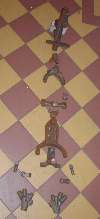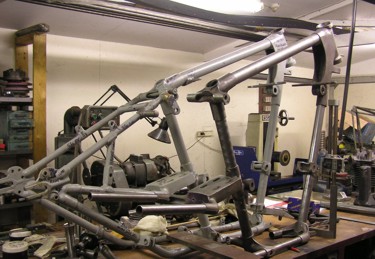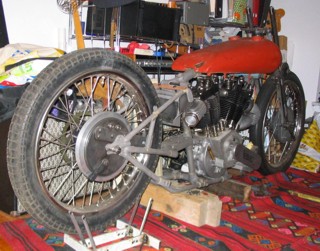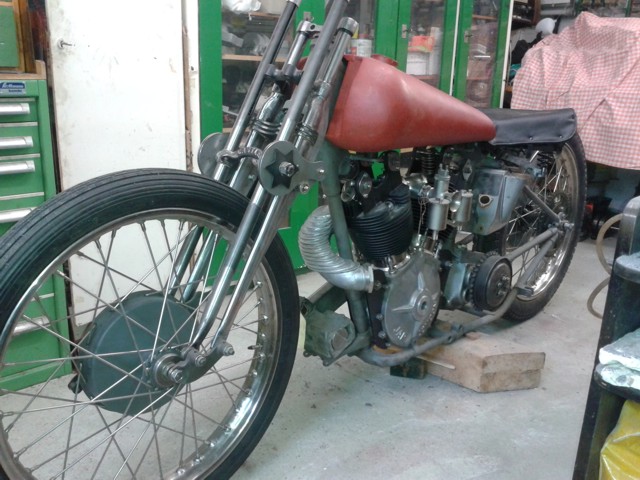| As a start, I have obtained a set of unmachined lugs, but I am none too happy
with them. I understand these lugs were originally moulded off a
late-twenties 680 o.h.v. frame that had been sawn up for re-tubing. While
people have built SS100 frames from them, I can see the following problems:
- They are cast from SG iron. Originally, white malleable iron was used
for the lugs of brazed frames.
I am afraid I will have to give a small
lecture on ferrous casting materials here in order to explain the problem.
There are five basic types of material for ferrous castings:
| material |
easy to cast |
welding properties |
ductility |
strength |
| grey cast iron |
++ |
-- |
-- |
o |
| white malleable iron |
++ |
++ |
++ |
+ |
|
black malleable iron |
++ |
- |
++ |
+ |
|
spheroidal graphite (SG) iron |
+ |
o |
+ |
+ |
|
cast steel |
- |
++ |
++ |
++ |
Grey cast iron has a high carbon content which makes it
flow very nicely into the mould. During the solidification, the carbon
forms small graphite flakes, which make the casting very brittle, but give
good damping and sliding characteristics. Cylinder barrels are made from
grey cast iron.
White malleable is produced by heat treating grey cast
iron bits at 1050° C for 4-6 days in an atmosphere that does burn the
carbon in the iron. Thus, a tough and malleable iron with low carbon
content is produced, having good welding and brazing properties.
Unfortunately, there are almost no foundries left that still do this
treatment.
With black malleable, the carbon is not burned altogether,
but transformed into a kind of coal. This makes the material ductile, but
it cannot be welded or brazed.
In the 1970's, spheroidal graphite (SG) iron has been
invented. In this type of iron, the carbon does not form flakes like in
grey cast iron, but very small graphite spheres, which is achieved by
adding small quantities of magnesium into an otherwise very pure iron. The
lower strength varieties of SG are quite ductile (15 .. 18 % elongation),
while the stronger types have only some 5% elongation.
While this would be ok, the main problem is that welding and brazing it
can produce unpredictable results, as the delicate equilibrium of the
structure may be disturbed quite drastically due to the heat of the
process. Brazing and welding can be done, if the very process with its
specific temperature gradients has been proven to be acceptable by
destructive material testing. But everybody who has yet brazed up a frame
lug with an open flame knows that you have a very poor control over the
heat range and time gradients, usually you are happy if you have got the
braze well into the joint and not burnt the bit!
Cast steel finally combines high strength with high
ductility and very good welding properties, but it is very difficult to
cast due to the higher temperatures and greater shrinkage.
From the above you can conclude that cast steel is the
only fully-fledged alternative to white malleable iron, which,
unfortunately, is almost unobtainable these days.
-
Then, the above mentioned lugs have been cast from the
original ones 'as is'. This means, they have neither machining allowances
nor any allowances for shrinkage. This means that they become a bit thin
in some places if you bore them to accept the original tube sizes and you
get quite thin rear fork ends etc...
- Lastly, it is debatable whether or not the same lugs were originally
used for the 680 and SS100 frames. Some people say there is not one common
lug on both of these frames, some say it is only the front bottom lug
which is different. I will have to find out about this...
5/2005: I have now made many
investigations into this matter. I have taken measurements from a number
of bikes, and have spent many hours consolidating these in CAD drawings.
My conclusions are the following:
- Before the arrival of the Alpine Grand Sports SS100 model, the 680
ohv, the SS80 and the SS100 shared most of the frame lugs, with the SS100
frames just being built a bit higher to accommodate the ohv engine.
- The AGS frame, which appeared in the end of 1926, was a quite radical
re-design. It used a different headstock casting, having twin
reinforcement webs running from the top tube to the front down tube (the
so-called box-type headstock). The centre of gravity was set a bit lower,
and with most of the lugs, the angles included between the tubes are
different from those on the pre-AGS frame. This is certainly true for the
rear fork lugs, the seat lug, the gearbox bridge, the seat down tube
bottom lug and the front down tube bottom lug. So these two frames
have very few lugs in common, if any.
- The late 1920's SS80 frames are still pretty similar to the pre-AGS
SS100 frames, my guess is that G.B. used up the old lugs for these. With
the 80-100 frames I don't know. I have heard of one which has a box-type
headstock, and another one that hasn't.
|

|
|
2005-2022:
Many years have gone by.
Life has not been easy all the time but I do not want to complain. I have not managed to do much in the past 15 years, and not updated these pages.
The good news is that I have been able to take early retirement recently, and I am back at it!
I will just try to shortly sum up what has happened. I had realised that building my own steel frame lugs was a fairly big a task, and when, some time in 2005, Howard Wilcox offered a batch of replica frames made to the pattern of his 1927 AGS SS100 I bit the bulllet and paid a deposit.
The frames were made in New Zealand. I got in touch with the guy making them and I must take my hat off to him - he did an absolutely marvellous job. He told me, though, that it took a long series of frustrated attepts at casting the steel lugs and it only worked out when the foundry would set him a space apart, allowing him to do all the moulding himself!
|

|
Ok, to put a long story short: I made a set of new, longer and more sturdy forks for it. It was quite a saga, I will occasionally give an account on my "CASTLE" page.
There are 15 years lying between the two pictures on the right, and you could say there is not too much of a difference between them - well at least the lower frame rails are lying horizontal now, although the gronud clearance is maybe a bit high.
Er... don't tell me the surroundings in the first pic looks like a messy teenager's room, I know :-)...
|


|
 Vintage Workshop
Vintage Workshop Vintage Workshop
Vintage Workshop![]() is
appreciated
is
appreciated